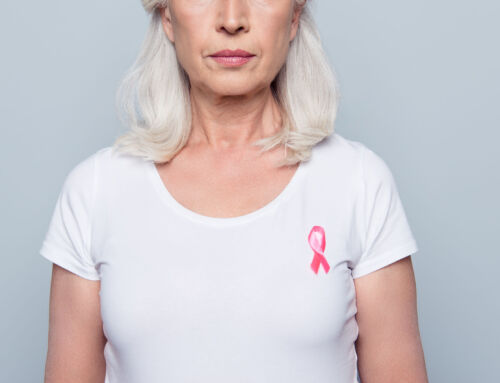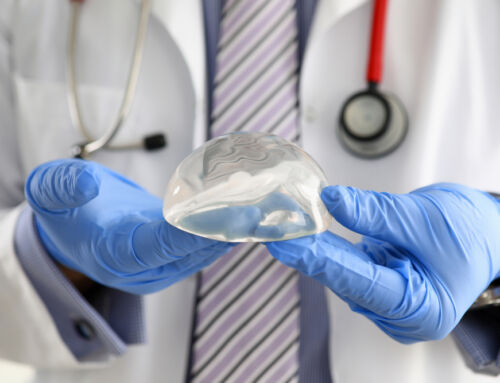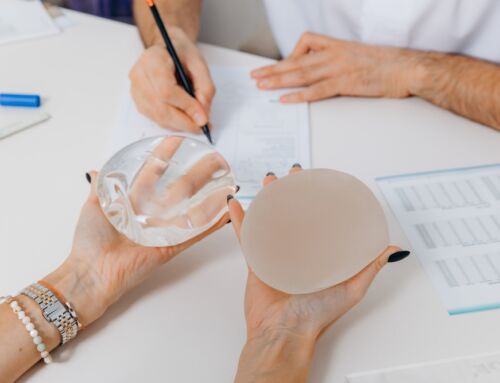
With Breast Cancer Awareness Month in October upon us, we are reminded of the countless individuals who have bravely navigated the challenging path of breast cancer diagnosis and subsequent mastectomy surgeries.
For many, breast reconstruction becomes a vital part of their healing process. This decision is profoundly personal, demanding thoughtful consideration of the available options, each offering unique benefits and considerations.
Today, women facing this choice have two primary types of breast reconstruction procedures to consider: implant-based reconstruction or soft tissue-based reconstruction.
Implant-based breast reconstruction is the most common choice and often proves convenient regarding recovery and downtime. However, soft tissue reconstruction has been gaining popularity, primarily due to its ability to recreate a more natural look and feel and minimize complications associated with foreign materials.
There are several soft tissue reconstruction methods. Among the most prominent is the Deep Inferior Epigastric Perforator (DIEP) flap surgery. This blog will guide you through the essential aspects of soft tissue breast reconstruction, specifically focusing on DIEP Flap surgery.
We will discuss:
- What soft tissue breast reconstruction entails and the different techniques that can be used.
- What DIEP Flap surgery is, and why it is the preferred soft tissue breast reconstruction technique.
- Advantages of DIEP Flap surgery.
- A step-by-step guide of what to expect during the DIEP Flap surgery procedure.
- FAQs about DIEP Flap Surgery (the recovery process, when you can resume normal activities, expectations for how your breasts will look and feel after surgery, whether or not you can have nipple reconstruction after DIEP flap surgery, and more.)
- The risks of DIEP Flap surgery.
- Alternatives to DIEP Flap surgery.
- Where to find a trusted reconstructive plastic surgeon in Tennessee qualified to perform DIEP Flap surgery.
What is Soft Tissue Breast Reconstruction?
DIEP is a type of soft tissue breast reconstruction surgery, also known as autologous tissue reconstruction or tissue-based reconstruction. It is a popular method used to regain the breast’s natural shape after breast cancer surgery.
Unlike implant-based procedures, which introduce synthetic materials, soft tissue breast reconstruction utilizes the patient’s own bodily tissues to reconstruct the breast, minimizing potential complications associated with foreign substances and offering a look and feel that closely mimics the natural breast.
By skillfully relocating tissues from various donor sites, including the abdomen, back, thighs, or buttocks, surgeons can artfully craft a breast that not only mirrors natural aesthetics but also harmonizes with the body’s changes over time.
Much like implant-based surgery, different flap techniques can be used to reconstruct the breasts. They fall into two principal categories: pedicle flaps and free flaps.
Pedicle Flaps
Pedicle flaps are a type of tissue transfer that involves moving tissue while keeping it connected to its original blood supply. This connection ensures that the tissue remains viable and healthy during relocation.
The most commonly used pedicle flap for breast reconstruction is the latissimus dorsi (LD) flap. This technique utilizes tissue from the back, comprising skin, fat, and muscle, to create a new breast shape. Another option involves using tissue from the abdominal wall, known as the transverse rectus abdominis muscle or TRAM flap.
Free Flaps
On the other hand, free flap procedures involve completely removing tissue, including fat, skin, and sometimes muscle, from one area of the body to craft a new breast shape. This tissue is meticulously repositioned on the chest, necessitating the intricate reconnection of blood vessels (arteries and veins) to the chest wall’s blood supply.
This vascular reattachment requires the use of microsurgery, where tiny vessels are connected under a microscope. While free flap surgery tends to be more time-consuming than pedicle flaps, it offers distinct advantages.
Most notably, free flaps often do not require the removal of muscle from the donor site, reducing the risk of muscle strength loss. Additionally, the donor site typically exhibits better cosmetic outcomes compared to muscle removal.
The most frequently utilized donor site for free flap breast reconstruction is the abdominal wall (tummy). Other potential donor site areas for free flap procedures include the thighs, buttocks, and lower back.
DIEP flap surgery falls into the free flap category.
What is DIEP Flap Surgery?
Deep Inferior Epigastric Artery Perforator (DIEP) flap surgery is a free flap autologous surgery, which means that tissue from other body parts is used to complete the reconstruction.
Specifically for this reconstruction, a portion of skin, fat, and blood vessels is taken from the lower abdomen, specifically the lower abdomen below the belly button, to recreate the breast.
This area is often chosen as the donor site because it provides abundant skin and fat, making it well-suited for breast reconstruction.
Using the lower abdominal tissue in the DIEP flap procedure allows for a natural breast reconstruction while preserving the abdominal muscle integrity, resulting in quicker and smoother patient recovery compared to other flap methods.
The DIEP flap technique also spares the abdominal muscles, distinguishing it from the older TRAM flap procedure, where a portion of the abdominal muscle may be used as part of the tissue transfer.
Learn more about DIEP soft tissue based reconstruction in Dr. Garza’s video.
The Advantages of DIEP Flap Surgery
Don’t let the surgical complexity and longer initial recovery time steer you away from considering DIEP flap surgery to reconstruct your breasts. DIEP flap is an attractive option for many individuals seeking breast reconstruction after mastectomy.
Additionally, the patient gets a free “tummy tuck” out of the procedure, which can be an added benefit for those considering body contouring. It’s important to note that although the DIEP Flap procedure is sometimes likened to a tummy tuck, its primary objective is to achieve natural breast reconstruction. While certain patients may experience comparable toning and firming effects on their abdominal area, the outcomes may not be as dramatic for everyone.
While implants are a common choice for breast reconstruction, DIEP flap surgery has several advantages compared to an implant-based reconstruction and continues to gain popularity as a preferred option for breast reconstruction.
No Synthetic Materials
Unlike breast implants, which use synthetic materials, soft tissue breast reconstruction involves using your body’s own tissue. This approach not only ensures a more natural feel but also minimizes the risk of complications associated with foreign materials.
More Natural
DIEP flap surgery offers results that are remarkably natural in both appearance and texture. The transplanted tissue seamlessly adapts and ages along with your body, providing a breast reconstruction that feels and looks authentic.
Dynamic Adaptation
Another advantage of soft tissue breast reconstruction over implants is that the tissue flaps will change like any other tissue in your body. For instance, they may get bigger or smaller as you gain or lose weight. This dynamic adaptation can provide a breast appearance that harmonizes naturally with your overall body changes over time.
Less Chance of Reoperation
While breast implants sometimes need to be replaced (if the implant ruptures, for example), this is not a concern with tissue flaps. Tissue flaps are often used by themselves to reconstruct the breast, but some tissue flap procedures can be used with a breast implant if more volume is needed. This means fewer potential reoperations and less concern about implant-related complications.
Improved Long-Term Aesthetics
Over time, many patients find that the appearance of their reconstructed breast(s) remains more consistent and satisfying with DIEP flap surgery compared to implant-based reconstruction. The natural tissue ages with the rest of your body, offering a long-term aesthetic advantage.
How Is DIEP Flap Reconstruction Surgery Performed?
DIEP flap reconstruction surgery is a meticulously executed 6-8 hour surgical procedure that should only be performed by a highly-skilled, board-certified reconstructive plastic surgeon.
The versatility of the DIEP flap procedure allows it to cater to both single and bilateral breast reconstruction needs. Whether it is a single breast or both that require reconstruction, the process is the same.
Here’s a step-by-step breakdown of how DIEP flap surgery unfolds:
1: Before Surgery Begins
You will be provided pre-op instructions to follow leading up to the day of your surgery. Please follow these instructions meticulously to ensure your surgery can proceed and goes as smoothly as possible.
You will arrive at the hospital or surgical center on the day of your surgery. The medical team conducts a final review of the surgical plan and performs necessary pre-operative assessments. This may include reviewing medical history, verifying medications, and discussing last-minute patient questions or concerns.
You will then be prepared for anesthesia administration. Anesthesia is given to ensure you remain comfortably asleep throughout the surgery, eliminating any pain or discomfort. The anesthesia team will closely monitor your vital signs and overall well-being throughout the procedure, guaranteeing a safe and controlled surgical environment.
2: Incision and Tissue Harvest
The surgical process begins with a precise incision in the lower abdomen. Through this incision, a carefully selected segment of skin, along with associated fatty tissue and vital blood vessels, is gently extracted. These tissues bear a striking resemblance to natural breast tissue, making them an ideal choice for reconstruction.
3: Abdominal Closure and Contour Enhancement
Once the tissue extraction is complete, the abdominal incision is expertly closed. A refined technique is employed to reposition the abdominal skin, creating a smoother and more natural contour. Notably, special attention is given to repositioning the patient’s belly button to harmonize with the improved abdominal shape.
4: Tissue Transfer to the Chest
The harvested skin, fatty tissue, and crucial blood vessels are then meticulously relocated to the chest area. These tissues are secured in the precise location where the new breast is to be reconstructed.
5: Vascular Connection
To ensure the sustained vitality and proper function of the transferred tissue, the surgeon diligently connects the blood vessels within the flap to those naturally occurring in the chest. This microsurgical procedure demands a high level of precision and is pivotal to the success of the DIEP flap surgery.
6: Flap Placement
With the harvested tissue now prepared, the surgeon carefully places it in the designated area on the chest, where the new breast is being reconstructed. Every step is taken to ensure precise placement and alignment, considering both aesthetic and functional aspects.
7: Wound Closure
Once the flap is securely positioned, the surgical team meticulously closes the incisions with sutures, paying close attention to achieving optimal wound healing and minimizing scarring.
8: Postoperative Recovery and Monitoring
Following the completion of the surgical procedure, you will be transferred to the recovery area, where you will gradually wake up from anesthesia. Continuous monitoring of your vital signs will continue during this initial postoperative phase to ensure a smooth transition from surgery to recovery.
In most cases, patients undergoing DIEP flap surgery can expect to stay in the hospital for a few days following the procedure. This hospitalization allows for close monitoring of your overall recovery, the viability of the transferred tissue, pain management, and any potential complications.
What to Expect After DIEP Flap Surgery
After discharge, the recovery process continues at home. You will receive detailed postoperative care instructions, which may include wound care, pain management, and restrictions on physical activities.
Because DIEP flap surgery involves two sites on your body, it will take longer for your body to fully recover. It is imperative to allow your body all the time it needs to heal. You will have surgical drains that will remain for one to two weeks after surgery, depending on whether one or two breasts are reconstructed.
You must avoid heavy lifting, strenuous exercise, and sexual activity during your recovery period. Additionally, your doctor will advise you to start stretching exercises after reaching a certain point in your recovery.
Follow-up appointments with your surgical team will be scheduled to monitor your progress and address any questions or concerns that may arise during the healing process.
How Extensive is the Recovery Period from DIEP Flap Surgery?
DIEP flap surgery has a unique recovery timeline that varies from other reconstruction methods. Recovery time is roughly double the recovery time of implant-based reconstruction.
Unlike implant reconstruction, where patients can typically go home the same day, DIEP is a more meticulous surgery, which means recovery usually involves a short hospital stay of approximately three to five days.
Once discharged from the hospital, the recovery process at home is also slightly longer than implant reconstruction. You should anticipate that your overall recovery may take up to eight weeks or more.
This extended recovery duration is primarily due to the surgical intricacy of DIEP flap surgery, which involves tissue transfer and microsurgical techniques and is somewhat longer than implant-based reconstruction.
Every patient’s recovery experience is unique and influenced by factors such as overall health, surgical complexity, and the extent of the procedure. Your surgical team will provide personalized postoperative care instructions and closely monitor your progress during follow-up appointments.
While the recovery period may be longer, many patients find that the results, which closely mimic natural breast tissue, are well worth the investment in time and care.
How Will I Feel After DIEP Flap Reconstruction Surgery?
Immediately after your surgery, you will feel sore around your breast and abdomen.
As the weeks pass, you can expect a gradual improvement in your pain and soreness.
Remember, your body has undergone a transformative process, involving the careful transfer of tissue and intricate microsurgery, requiring time to adjust and heal. While the immediate postoperative phase may present challenges, our surgical team will be by your side, providing guidance and support to help manage any discomfort.
You will be given detailed postoperative care instructions, which may include pain management strategies tailored to your unique needs, ensuring that you are as comfortable as possible during this period.
How Long Until I Can Exercise After Surgery?
As stated earlier, you should avoid strenuous exercise after your surgery. After about two or three days, you will be advised to start doing some arm exercises to help your muscles function and heal properly. You can do some isolated exercises to help prevent blood clots.
The general window before you can exercise again is about 5 to 6 weeks. However, everyone’s recovery process will look different, so you should always consult your doctor before engaging in any vigorous exercise.
You should also not lift anything above your head during your recovery period, as it could damage the rebuilt breast and cause complications.
How Will My Breast(s) Feel After DIEP Flap Reconstruction Surgery?
Initially, after your surgery, you might notice some changes in sensation. In some cases, you may even experience numbness in the breast area. This is a common occurrence following surgery of this nature.
The reason behind this temporary sensation alteration lies in the intricate way in which your plastic surgeon rebuilds your breast. The procedure involves using your body’s own skin cells, fat cells, blood vessels, and nerves to reconstruct the breast, ensuring a natural look and feel.
Over time, as your body heals and the nerves begin to regenerate, you should notice a gradual return of sensation. While sensation may not fully revert to its pre-surgery state, you can expect an improvement in feeling as your healing progresses.
As you reach the milestone of complete healing, you should experience the return of sensation and find that your breasts feel increasingly natural. This is a key advantage of the DIEP flap reconstruction method—it allows your body’s own tissues to create a breast that looks and feels remarkably similar to your natural breast.
Can My Nipples Be Reconstructed with DIEP Flap Surgery?
When you undergo a mastectomy to remove breast cancer, you may receive either a nipple-sparing mastectomy or a non-nipple-sparing mastectomy.
During nipple-sparing breast cancer removal, your surgeon will make incisions around the nipple to keep the rebuilt breast mound as natural-looking as possible. However, there might be scarring left behind, or you might not be able to have nipple-sparing surgery. In this case, some people opt to have nipple reconstruction surgery.
Typically, nipple reconstruction surgery is not performed at the same time as DIEP Flap surgery. Waiting until your breasts heal from the initial DIEP flap procedure is advised. This allows for optimal healing of the breast mound following the intricate tissue transfer process.
Once your breasts have sufficiently healed, a skilled reconstructive plastic surgeon can undertake the task of nipple reconstruction. This process typically entails utilizing your body’s natural tissues to craft a lifelike nipple and incorporating tattooing to recreate the natural appearance of the areola—the pigmented area surrounding the nipple.
Risks of DIEP Flap Surgery
Like any surgical intervention, DIEP Flap surgery does carry some inherent risks. These risks, though they exist, are common in many surgical procedures. Your surgical team will take every precaution to mitigate these risks and ensure your safety throughout the journey.
Fat Necrosis
This condition occurs when the transferred tissues do not receive sufficient blood supply to oxygenate the cells. As a result, the fat tissues without enough blood harden and die, causing lumps in the reconstructed breast.
Symptoms include discoloration at the reconstruction site, the breast becoming cold to the touch, fever, and the development of open wounds in the later stages of necrosis.
Your plastic surgeon can remove the necrotic tissue with further surgery while maintaining the shape of the breast.
Abdominal Hernia
Because DIEP flap surgery takes tissue away from your abdomen, there is a small risk of developing an abdominal hernia. To reduce the risk of developing a hernia, you should rest and avoid lifting heavy objects or straining your abdominal muscles.
Thankfully, the risk of a hernia is much lower if you undergo DIEP flap surgery, especially when compared to the risks associated with TRAM flap procedures that take fat and muscle from the donor site.
Abdominal Weakness
As your body heals from the procedure, you will likely experience abdominal weakness, soreness, or pain. But that weakness will improve over time once you return to your full activity level.
Blood Clots
One of the more serious risks associated with DIEP flap surgery is blood clots and pulmonary embolism. Your risk for blood clots may be higher depending on your health history, especially if you smoke regularly.
While preparing for surgery, your doctor may give you blood thinners or other preventative medications before your surgery.
Infection
Any wound to the body is at risk for infection. Even with the highest levels of sanitation, infection can still occur around either the reconstruction site or the donor site. Fever, fluid build-up, pain, swelling, and redness are all signs of a possible infection.
Fluid Build-Up
Medically referred to as seroma, the buildup of plasma fluid around the surgery sites that results in a small, swollen lump. Patients often develop seromas after DIEP flap surgery, which is why surgical drains are placed in the reconstructed breast to give the plasma an outlet. But, even with drains, the plasma can collect under the incision site and create seromas.
Typically, a seroma is harmless but can result in an infection. An infected seroma should be drained or removed before the infection spreads and damages other tissue.
Flap Failure
If tissue necrosis occurs throughout the entire breast flap, the flap has reached total failure. When this happens, the entire flap must be removed through surgery. If the dead flap tissue is removed in time, your surgeon might be able to use that tissue. However, once the flap is removed, it must be replaced.
Dog Ear Scars
These form on the ends of the abdominal scar after DIEP flap surgery. Dog ears are harmless deposits of skin and fat that fold or droop over the incision scar. Usually, dog ears will go away on their own.
If you don’t see signs of improvement, you can massage the scar until it goes away. If they don’t go away on their own, your plastic surgeon can perform a revision surgery to get rid of the dog ears.
When to Call Your Doctor After DIEP Flap Surgery
Recovering from DIEP flap surgery requires close attention to your body’s signals. It’s crucial to know when to reach out for medical assistance. Here’s when you should contact your healthcare provider:
- Unusual Bleeding: If you notice any excessive or persistent bleeding, it’s important to seek immediate medical advice.
- High Fever: A significant increase in body temperature could indicate an infection, so don’t hesitate to call your doctor if you develop a fever.
- Intense Pain: While some discomfort is normal, severe pain that doesn’t subside with prescribed medication is a red flag.
- Difficulty Breathing: Experiencing shortness of breath (dyspnea) can be serious and warrants prompt medical attention.
- Infection Signs at Incision: Look out for symptoms like pus, unpleasant-smelling discharge, or increased redness around the incision sites. These could be indicators of infection.
By being vigilant about these symptoms, you can ensure a smoother recovery and address potential complications swiftly. Always trust your instincts and contact your healthcare provider if something doesn’t feel right.
Who Should Avoid DIEP Flap Surgery?
DIEP flap reconstruction isn’t suitable for everyone. Here are key factors that might make you ineligible for this procedure:
- Previous DIEP or TRAM Surgery on the Other Breast: If you’ve already undergone tissue removal from your abdomen for reconstruction, the remaining tissues might not suffice for another DIEP flap.
- Lack of Adequate Abdominal Fat and Tissue: Individuals who are very slim or have undergone procedures such as a tummy tuck or liposuction may not have enough excess tissue required for the surgery. In certain scenarios, a stacked DIEP surgery, which utilizes tissue from both sides of the abdomen, may be considered.
- Abnormal Abdominal Blood Vessels: The presence of small or poorly located blood vessels can complicate this type of surgery. Although advancements in surgical techniques are expanding possibilities, these issues may still pose significant challenges.
- History of Certain Abdominal Surgeries: Prior extensive abdominal surgeries, like abdominal wall reconstruction or procedures like a colostomy, might hinder the ability to perform a DIEP flap surgery. However, many patients can still be eligible after less complex surgeries, such as a C-section or tubal ligation.
Alternatives to DIEP Flap Surgery
As previously mentioned, there are two primary soft tissue breast reconstruction techniques: pedicle flaps and free flaps, with DIEP Flap surgery as the preferred method.
Another widely considered option in tissue-based reconstruction is the TRAM flap reconstruction. However, it’s important to note that DIEP surgery often presents fewer risks and specific advantages.
During a TRAM reconstruction, abdominal muscles, skin, fat, and blood vessels are removed from the abdomen to reconstruct the breast. In contrast, a DIEP surgery preserves the abdominal muscles, resulting in several patient benefits, including reduced postoperative pain, minimized abdominal wall weakness after surgery, and a lowered risk of hernia formation.
Another noteworthy alternative for those considering breast reconstruction following a mastectomy is implant-based breast reconstruction. In this approach, synthetic implants are used to rebuild the breast tissue, offering a different avenue toward restoration.
Understanding each method’s unique characteristics and advantages is essential for making an informed decision regarding your breast reconstruction journey. In this video, Dr. Robert Garza discusses the most common procedures and what he looks for when determining candidates for each type.
DIEP Flap Surgery in Nashville, TN
DIEP flap surgery is a specialized procedure that demands a unique skill set. It should only be performed by a qualified reconstructive plastic surgeon with extensive experience in this precise field of surgery.
Dr. Robert Garza, a seasoned expert in the realm of tissue-based breast reconstruction, has a dedicated focus on DIEP Flap surgery (tissue-based breast reconstruction) and is dedicated to offering patients the highest level of care and expertise.
Call us today at (615) 620-7800 to schedule a consultation with Garza Plastic Surgery in Nashville, TN to discuss whether or not DIEP flap surgery is a good fit for you. If not, we can offer a variety of alternatives and answer any questions you may have to help find the best solution for your goals and medical needs.
Recognizing Breast Cancer Awareness Month
In discussing breast reconstruction, it’s fitting to take a moment to acknowledge the significance of Breast Cancer Awareness Month, observed each October. This annual observance is a powerful reminder of the countless individuals who have embarked on the challenging journey of breast cancer diagnosis and treatment.
It is a time when communities come together to honor the resilience of breast cancer survivors, honor the memory of those who have passed away, and champion ongoing research and education in the fight against breast cancer.
In the spirit of this month, we encourage you to prioritize your breast health by scheduling a mammogram. Early detection can make all the difference in the battle against breast cancer. Additionally, please urge the women in your life to do the same.
DIEP FLAP SURGERY: TISSUE BASED RECONSTRUCTION
When it comes to present-day breast reconstruction, we’re referring to implant based and soft tissue based options. While implants offer a popular, simple method, there are alternatives for reconstructive breast surgery like DIEP flap surgery (soft tissue based breast reconstruction). Find out the advantages of soft tissue based reconstruction in Dr. Garza’s video.
SOFT TISSUE BASED RECONSTRUCTION
What is DIEP flap surgery breast reconstruction? What’s the difference in soft tissue based reconstruction versus implant based reconstruction? Soft tissue based reconstruction, like DIEP flap surgery, uses the patients soft tissue that usually comes from the back, leg or other areas. While the recovery is longer for a soft tissue based reconstruction, most patients who choose this method prefer the “tummy tuck” results that come along with this procedure without having implants.





